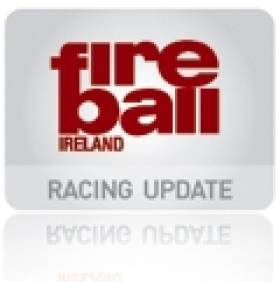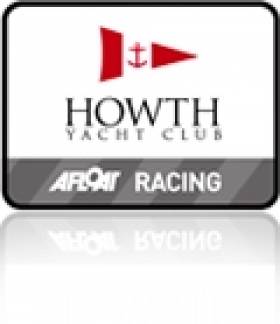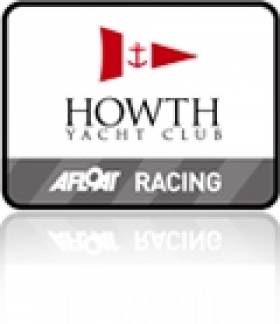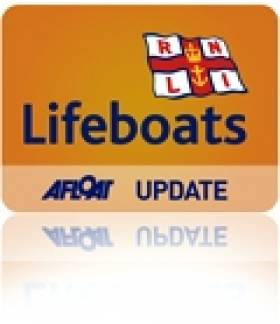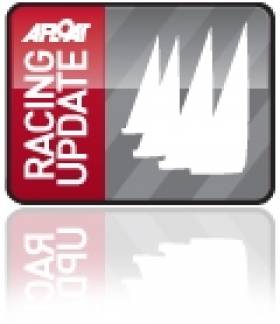Displaying items by tag: yacht
McGrotty and Grimes Win Fireball Ulster Title
Representatives from Skerries (2), Clontarf (1), Howth (2), East Down Yacht Club (1), Sligo Yacht Club (1) were joined a composite crew from Cushendal Sailing and Boating Club/Royal St. George Yacht Club and eleven boats from Dun Laoghaire.
In times past the Fireball Class were regular visitors to Ballyholme, particularly when they hosted a week-long dinghy regatta, but in the time of this scribe’s association with the Irish Fireball Class this has been our first visit. Ballyholme has had a solitary Fireballer in recent times, but unfortunately Denis Findlay lost his struggle with cancer and so he was unable to enjoy the return of the class to this venue on Belfast Lough.
Race Officer Robin Gray, RYA N. Ireland’s Race Officer Co-ordinator did the honours over the weekend and enhanced his reputation as an excellent RO with three superb races on Saturday when we enjoyed a sea breeze of 15/16 knots. In addition to good courses we enjoyed sea conditions that gave us excellent surfing conditions and saw a few stories of rogue breaking waves in Saturday’s post-mortems. Turnaround times for races were good to the extent that after a solitary black flag start in Race 1, after a General Recall, three hour long races were sailed in beautifully sunny conditions that saw the fleet ashore and showered by 16:30.
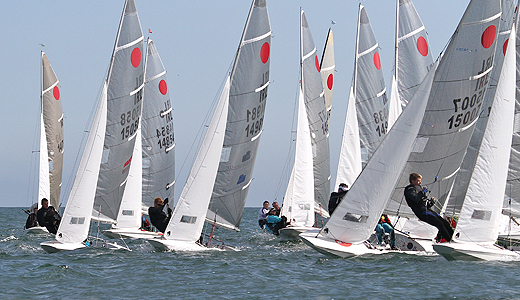
I gather that Sunday was not quite as co-operative from a wind perspective as the wind started light and moved around much more. Due to a family bereavement, I missed the day’s proceedings but was updated on how the day panned out.
Day 1 was claimed by Simon McGrotty & Ruari Grimes who won races 1 and 3 with good upwind speed on the beat and excellent boat handling off wind, particularly in the tight first reaches of the triangles. The blot on their day 1 record was a fourth place which may have been influenced by a wandering gybe mark which had to be substituted by a rib flying an X Flag. There certainly was the unusual sight of Fireballs beating and tacking towards the gybe mark and McGrotty/Grimes may have lost places here. Kenny Rumball & Seamus Moore, Barry McCartin & Conor Kinsella and Damien Bracken & Brian O’Hara were able to take advantage by filling the first three places before McGrotty/Grimes finished in fourth.
After three excellent races, the standings were as follows;
1. Simon McGrotty & Ruari Grimes 6pts (1,4,1)
2. Kenny Rumball & Seamus Moore 8pts (4,1,3)
3. Barry McCartin & Conor Kinsella 10pts (6,2,2)
4. Noel Butler & Stephen Oram 13pts (2,7,4)
5. Louis Smyth & Cormac Bradley 16pts (3,8,5)
The silver fleet was 5-strong for this regatta and included a visitor from the UK. Hannah Showell teamed up with Margaret Casey to provide the third all-female crew of the event and together with Cariosa Power & Marie Barry, Mary Chambers & Brenda McGuire, they contested the regatta with Kate Grimes (helm), Martina Michels (crew) and Karen Caughey (crew), the latter three being joined by Nick Malone, Cearbhall Daly and John Orr respectively. Diane Kissane was the sole female outside the Silver fleet, sailing 14939.
What is encouraging for the Irish fleet at this point in time is the influx of young talented sailors into the class. Yes, it may be coincidental with the hosting of the Worlds, but it seems that they are enjoying themselves and there is a camaraderie that is developing among them and with the more “established” members of the fleet. This weekend we were joined by Luke Malcolm & Shane Diviney who bought a Fireball on the back of the Leinsters sailed in their home club of Howth last year. Howth is also scheduled to host the 2012 Nationals and we hope to have fledgling fleet there by the time we visit next summer.
Barry McCartin has joined the fleet from the Topper Class where he has enjoyed significant success. Diane Kissane has proven her pedigree in Optimists and has been showed a great turn of speed and ability to handle the Fireball in a very short time. There are other young recruits to the class who contested the Worlds in Ben Malone and Ben Scallan and the hope must be that we can continue to attract this age of competitor to ensure that we remain at the forefront of domestic sailing in Ireland and beyond.
My detail on Sunday’s proceedings is based on word of mouth reports from my helm, but I gather that the day’s wind wasn’t quite as steady as Saturday’s. It doesn’t seem to have upset the McGrotty/Grimes charge to the title as they bagged another two firsts to give themselves two-thirds of the regatta’s race wins. The one that “got away” on Sunday went to Frank Miller and Grattan Donnelly.
Counting all races, for the sake of analysis, Conor Clancy & Francis Rowan won by a healthy margin, counting a 2,2,4 for the day. On Saturday they had a complicated capsize in race 1 and retired from Races 2 & 3 due to a broken spreader. Thus while they didn’t feature overall on Saturday evening their success on Sunday saw them finish 7th overall.
McGrotty/Grimes had the next best daily score of 12 points (1,10,1), the 10th becoming their discard, with Rumball/Moore next best with 5,6,2. Butler/Oram’s travails continued with a 4,5,5, for the day which is completely inconsistent with their recent form. Damien Bracken and Brian O’Hara also had a better day with a 8,4,3.
In the Silver Fleet Hannah & Margaret had a three point lead over Cearbhall & Martina at the close of racing on the Saturday evening, with Cariosa & Marie in third place a further three points adrift. Cariosa & Marie won the second day with two finishes just outside the top ten and an 18th to Hannah/Margaret’s 11,12,DNF to leapfrog Cearbhall/Martina into 2nd place in the Silver fleet.
As ever with our northern visits, the hospitality of Ballyholme Yacht Club was excellent with a dinner arranged for the Saturday night at which some unfinished business (a prize-giving) from the Open Championships was concluded. The atmosphere in the Club was welcoming and in particular their provision of race results on both Saturday evening and Sunday afternoon was very fast with multiple score sheets being made available.
Robin Gray will definitely be on our wish list for future events, particularly as he ran the regatta exactly as we asked him to. Our thanks also go to Mark Markey, Rear Commodore Sailing who coordinated our visit from a BYC perspective.
The Class now enjoys a month’s break until the Nationals which are being hosted by Dun Laoghaire Motor Yacht Club on Dublin Bay over the last Friday/Saturday/Sunday of August, 26 – 28th. Class coordinator for this event, Neil Colin, has secured sponsorship from Pinnell & Bax and the regatta documentation can be found on both the Irish Fireball website and the club website.
The decision to go with a Dublin venue was taken in view of the two-week Worlds regatta in Sligo so that we didn’t have to embrace another distance regatta for the Nationals. Additionally, in recent years the Nationals have been hosted outside the capital (Baltimore, Westport (x2), Cork, Fenit, Wicklow) and the feeling was that it was time for them to return.
|
Pos |
Sail No |
Crew |
R1 |
R2 |
R3 |
R4 |
R5 |
R6 |
Nett |
|
1 |
14981 |
Simon McGrotty & Ruari Grimes |
1 |
4 |
1 |
1 |
10 |
1 |
8 |
|
2 |
15058 |
Kenneth Rumball & Seamus Moore |
4 |
1 |
3 |
5 |
6 |
2 |
15 |
|
3 |
14820 |
Barry McCartin & Conor Kinsella |
6 |
2 |
2 |
6 |
3 |
7 |
19 |
|
4 |
15061 |
Noel Butler & Stephen Oram |
2 |
7 |
4 |
4 |
5 |
5 |
20 |
|
5 |
14904 |
Damien Bracken & Brian O’Hara |
20 |
3 |
6 |
8 |
4 |
3 |
24 |
|
|
|
|
|
|
|
|
|
|
|
|
14 |
14775 |
Hannah Showell & Margaret Casey |
12 |
13 |
13 |
11 |
12 |
20 |
61 |
|
15 |
14854 |
Cariosa Power & Marie Barry |
15 |
14 |
15 |
18 |
11 |
11 |
66 |
|
16 |
14877 |
Cearbhall Daly & Martina Michels |
14 |
15 |
12 |
14 |
18 |
13 |
68 |
Optimist Sailor Hyland Wins Howth Dinghy Regatta
Howth 17 Rita Sails to Another Win off Howth
King One Sails Home with a Win in Howth
Deilginis Sails Home as Top Howth 17
Four Oppy Fleets Take to the Water in Crosshaven
Five Rescued When Yacht Gets Tangled in Galway Bay
Galway's RNLI lifeboat was dispatched to retrieve the men after their distress call to the Irish Coast Guard.
The men were en route to Rossaveal Harbour at the time when their yacht became tied up in fishing pots.
Celtic Mist Reaches Scotland, Ready for New Life
The yacht once owned by former Taoiseach Charles Haughey will return to Ireland next week for its new life as a marine research vessel after completing the first leg of the 2011 Tall Ships Races.
The 52-foot Celtic Mist, the only Irish entrant in this year's races, came "a respectable last in our class”, skipper Fiacc Ó Brolcháin told The Irish Times from Scotland.
As previously reported on Afloat.ie, the yacht will know be fitted out with scientific instruments after it was gifted by the Haughey family to the Irish Whale and Dolphin Group (IWDG) to support its conservation work.
Oona Wins in Howth
Irish Yacht Wins Three Peaks Yacht Race
The victory was all the remarkable given the Ker 35 was last across the line after a disastrous start. The race began at Barmouth on the mid-Wales coast last Saturday and sea conditions were treacherous with 20 foot waves making it difficult for the race fleet to even leave the harbour.
Danu Techologies, entering the race for the first time, was still being prepared minutes before the start, had to be cut from its moorings and then suffered damage as it motored through the worst of the seas to the start line. Crashing down from a big wave one of the runners aboard was swept across the deck and broke a stanchion, which then punctured the jib, and the navigation computer on which the race route had been planned was destroyed. As the start flare fired the boat was out of position with its mainsail trailing, yet the crew of 3 and their two mountain runners finished the race as winners. They made the 6th fastest passage to Caernarfon, where elite Irish mountain runners, Deon McNeilly and Gary Bailey, made the 24 mile crossing of Mount Snowdon, the highest point in Wales, in the hours of darkness in 5 hours and 10 minutes. After a safe passage of the Menai Strait, and with light winds prevailing, the racing pedigree of a boat designed originally for the IRM Grand Prix rule enabled the team to take the lead. The runners then stayed ahead on the longest land stage, reaching Scafell Pike, England's highest summit, after a mountain bike ride to Ennerdale and a run across Black Sail Pass, which took 8 hours and 6 minutes.
The 32 boats taking part faced strong headwinds, then light airs and periods of calm on the route around the Mulls of Galloway and Kintyre and up through the Inner Hebridean islands to reach Fort William, and the final summit, Ben Nevis. A unique feature of the race is that yachts are rowed through periods of calm and the crew of Andrew Miles and John Prudhoe, took their turn at the oars when required to stay ahead of the challenge from Team Whistler, an Australian team who have formerly won the Tasmanian 3 Peaks Yacht Race and were looking for a unique double win in a Reflex 38. Unable to make up the deficit when they arrived second at Fort William the Australian team switched tactics to win the Tilman Trophy, which requires 4 of the team to reach a mountain summit. Skipper David Rees and crewman Tim Jones put on their walking boats to climb Ben Nevis and claim the prestigious trophy, though they did lose second place overall to Team White Cloud, a HOD 35, skippered by John Donnelly.
The other major trophy of the race, for the Kings of the Mountains, went to endurance runners Martin Beale and Ian Ridgeway, who were racing on team Peaks Addix. They were fastest on all 3 peaks and had a total running time of 13 hours 30 minutes, 2 hours ahead of their nearest challengers.
From the 32 starters there have been 5 retirements and 4 boats are presently still making their way to the finish. At the back of the field is another international team, The Flemish Lowlanders, whose runners were involved in a dramatic rescue of two climbers on Scafell Pike on Tuesday. The Belgian team have until the course closes at 18.00 on Saturday to reach the finish line and complete the race.


























